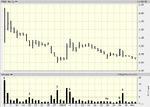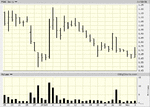If you're interested in my take on this, I'll be happy to provide it if and when you open up a journal and transfer all of this there. Having all of your stuff in one place will aid your learning curve.
Db
Following up on the above, I've posted the charts below.
1. You're correct about the SC. However, an SC rarely translates into a bottom. The actual bottom may not occur until days or weeks later. Therefore, there's no reason to expect the bottom of the bar to provide S (rather than go again into what provides S/R, I'll refer you to my S/R thread). The fact that price rises well off the low suggests that selling is at least slowing down coincidentally with an increase in buying pressure (hence the degree of trading activity), but this may be likened to pumping the brakes when trying to come to a stop. The stock after all fell 200pts.
2. At this point, zoom in on the area of interest so that you can see what you're doing. There is movement here which is difficult to detect when the action is so squashed.
You are correct that a falling price on lower volume suggests weak buying pressure. But what price is
going to do is not your concern. Focus on the moment.
Price makes a NL @2 and the bar after, but all the bars thereafter are inside bars. Therefore, there's no SP to provide S. There may be some S provided by the sideways movement, and the trader may want to bracket the trade, but experience would likely tell him that a long is far too early and a short far too late. Since there has as yet been no test, there's no downside to waiting for it.
3. Price makes a NL @3 on increased TrAc and closes well off the low, suggesting that buying pressure is finally entering the match. But, again, this is not necessarily S, for the same reasons provided in (1).
4. (3) now becomes an SP and potential S, though in and of itself, the S is weak. But there's no trend reversal or even a potential for one. A trend reversal will be a long time coming. When it does come, you may be too old to care.
5. There are of course sellers. Otherwise, there would be no TrAc at all. However, they do seem to be done. Why wouldn't they be? It's the people at home trading in their pajamas who are now interested in the stock.
However, if 4a were a test, the TrAc would be higher. There's no interest here, so there's little or no significance to this "low". The fact that the "lift" provided at 5 doesn't go anywhere supports this hypothesis.
6. The "rally" at 5 is aborted. There are still plenty of sellers out there, but far fewer than before, but there don't have to be as many as before since volume has been crap for so long. Many of those who bought after the SC are likely bored and want to put their money to better use elsewhere. They're done. They're out. There is still no definitive low, and the accumulation process has barely begun (given the price, it may not have begun at all and may never begin).
Looking solely at the evidence rather than at what you want or hope for, there's no hurry to do anything about this stock. If you want to stay in it, stay in it, but the evidence will not provide you with any reasons to do so, at least not yet. And in the meantime, there are opportunity costs to consider.
Db











